Compare and Contrast a Woman and Game Controller Funny
Brown, M. A., & MacKenzie, I. S. (2013). Evaluating video game controller usability as related to hand size. Proceedings of the International Conference on Multimedia and Human-Computer Interaction - MHCI 2013, pp. 114.1-114.8. Ottawa, Canada: International ASET, Inc. [PDF] [video]
Evaluating Video Game Controller Usability as Related to User Hand Size
Michelle A. Brown & I. Scott MacKenzie
Dept. of Computer Science and EngineeringYork University, Toronto, Canada
brown@cse.yorku.ca; mack@cse.yorku.ca
Abstract - This paper evaluates the relationship between hand size and the usability of the Xbox 360 controller, the Playstation 3 controller, and the Wii Remote and Nunchuck combination. The effect of hand size on user preference and ease of use is considered. In a study with 13 participants, user preference for each controller was solicited and ease of use was measured. A significant relationship was found between hand size and ease of use over all controllers. Participants with larger hands were able to easily operate a larger number of controls than those with smaller hands. No significant relationships were found between user preference and hand size.Keywords: Human-computer interaction; video game controllers; usability; hand size; user study.
1. Introduction
Video games have substantially increased in popularity over the last few decades. The industry now generates global revenue comparable to the movie industry (Tracy, Picon, 2010). Unlike the movie industry though, video game producers are not just concerned with the quality of the picture, audio, and storytelling, they are also concerned with playability. To make games more enjoyable and playable, developers now focus on usability to reduce frustration and to enhance the user experience.1.1. Related Work
There are many factors that influence the experience of the player. Work by Pinelle et al. (2008) and Federoff (2002) focuses on game design. Game design encompasses anything dealing with a particular game (i.e., user interface, control mapping, and artificial intelligence algorithms). The concern is with the software of the game and not with the underlying hardware. Pinelle et al. present a formal method of evaluating usability. The method was derived by analyzing reviews of 108 different games to identify categories of usability problems. Based on this analysis, a list of twelve classes of usability problems was created. Of these, five relate to the interface:
- unpredictable / inconsistent response to user`s actions
- clumsy input scheme
- difficult to control actions in the game
- command sequences are too complex
- response to user's action not timely enough
- provide consistent response to the user's actions
- provide intuitive and customizable input mappings
- provide controls that are easy to manage and that have an appropriate level of sensitivity and responsiveness
In the research by Federoff (2008), usability practices are examined with suggestions for improvement. Current usability practices deal with game control. Response time and control standardization are identified as important issues game developers should consider. The paper also discusses that while companies are now interested in usability, they do not yet have a formal method of achieving it. The paper concludes with heuristics for a formal usability evaluation method. Once again, many of these heuristics relate to the game controller. Problems with game interaction can occur not just in the control mappings, they can also occur in the controller itself. While the usability of games has been studied in these papers and others, a video game controller's effect on the overall gaming experience remains a relatively unexplored topic.
In modern systems there are many types of video game controllers, from classic controllers, like the Xbox 360 Gamepad Controller or the Playstation 3 Dualshock 3 controller, to more recent systems like the Nintendo Wii Balance Board or the Xbox 360 Kinect. In this paper, we focus on the standard handheld controllers of the current generation of gaming systems, specifically the Xbox 360 Gamepad Controller (Figure 1), the Playstation 3 Dualshock 3 controller (Figure 2), and the Nintendo Wii Remote and Nunchuck combination (Figure 5). These were chosen as they have a similar control scheme of buttons, analog sticks, and directional pads (D-pads). Also, many of the same game titles are available for all three platforms.
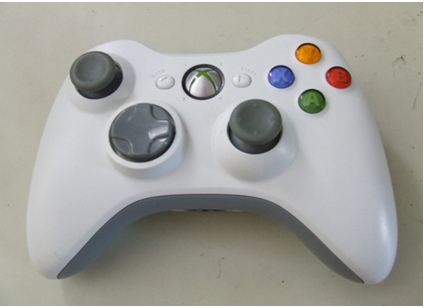
Figure 1. Xbox 360 gamepad controller.
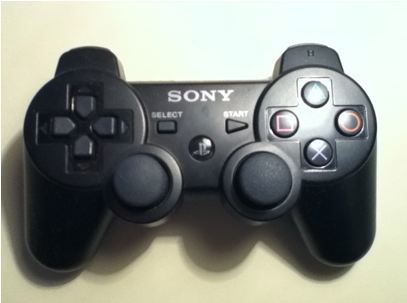
Figure 2. Playstation 3 Dualshock 3 controller.
While the usability of video game controllers has never been directly studied before, video game controllers are akin to handheld tools. In this respect there is a basis for comparison. Studies of the usability of handheld objects have been conducted for many years in other areas of research. The results, summarized by Sperling et al. (1993), indicate that hand size and hand strength both contribute to the usability of a hand tool. Most relevant to the study of game controller usability are the studies of the size of basketball suited to children (Regimbal, 1992) and the relationship between a surgeon's hand size and difficulty in using surgical instruments (Berguer, Hreljac, 2004).
In the research by Sperling et al. (1993), the effect of varying a basketball's size on the score, technique, and preference of children was examined using a men's, women's and junior standard basketball. While there was little difference in technique between the three balls, there was a significant preference for the junior size ball. It was also interesting to note that performance statistically improved when the child was using the ball that she or he preferred even if it was not the one she or he used most frequently. This, when combined with the knowledge that only three children in the study had previous experience with a junior regulation basketball, indicates that the children did not perform better with the smaller ball simply because it was familiar. When children used the junior standard basketball, the relationship between the ball size and hand size was comparable with that of adult males and a men's regulation basketball.
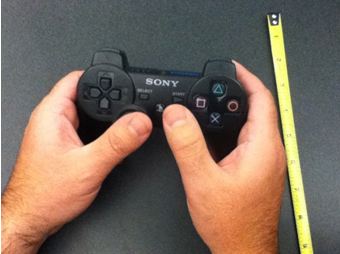
Figure 3. User with large hands can easily reach every button.
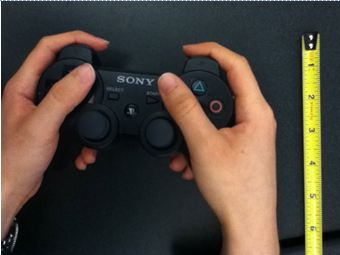
Figure 4. User with small hands must adjust their grip on the controller to reach more buttons.
In the medical paper on surgeon tool use, hand size was a significant determinant of the difficulty using laparoscopic surgical instruments. The study surveyed 726 laparoscopic surgeons on whether they experienced difficulty with five different laparoscopic instruments. It was found that surgeons who used glove sizes 6.5 or smaller reported more difficulty with instrument use, particularly with the stapler. It was concluded that based on hand size alone 36% of surgeons (87% female, 22% male surgeons) will experience significant difficulty using the tools. Ultimately, it was suggested that manufacturers of these tools should consider hand size variability in future designs.
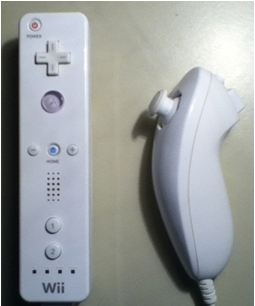
Figure 5. Wii Remote controller (left) and Wii Nunchuck controller (right).
Based upon these studies in other disciplines it can be concluded that controller size for gaming might have a significant effect on a player's preference and performance. As seen in Figure 3 and Figure 4 the differences in adult hand sizes can be substantial. A controller better suited to a player's hand size could make operation of the game easier and lead to less frustration and a better experience.
The standard method of measuring hand size is the volumetric method where a subject's hand is submerged in water with the displacement measured. This method is difficult, time consuming, and often expensive. The figure-of-eight method was designed to be easier and just as reliable (Pellecchia, 2003). In this method, the measurement uses string or a flexible tape measure. The string is wrapped around the participant's hand, starting at the wrist, crossing the back of the participant's hand, and ending back at the wrist (see Figure 6). Measurements generally yield about 13 inches for a small hand and about 19 inches for a large hand.
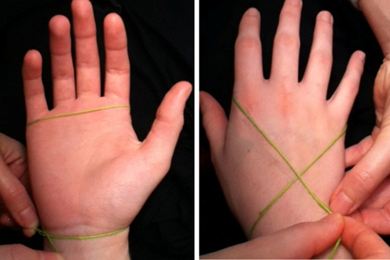
Figure 6. The figure-of-eight method of measuring hand size.
The remainder of this paper is organized as follows. First, the user study developed to test video game controllers is described. After this, the overall results are presented and discussed. The paper then concludes with a brief summary and thoughts about future work.
2. Methodology
2.1. Participants
Thirteen individuals from the local university campus volunteered to participate. Participants were an average of 32 years old with a median age of 30 years. Nine were male, four were female. Every participant but one was right handed and most were familiar with all controllers tested. Each individual provided informed consent before participation.
2.2. Equipment
A standard piece of string and a tape measure were used for measuring participants' hands. Also, a Wii Remote and Nunchuck (see Figure 5), a Playstation 3 Duelshock 3 Wireless Controller (see Figure 2), and a Xbox 360 Wireless Gamepad Controller were used (see Figure 1).
2.3. Procedure
First, the size of the participant's dominant hand was measured using the figure-of-eight method described earlier. After the participant's hand size was recorded the participant was given a brief questionnaire recording gender, age, and information about previous video game controller usage
The participant was then given a controller and asked to hold it in a natural position. The order that participants received controllers was counterbalanced so that the six possible orders were represented roughly equally (with two participants for each order, except for order one, which had three participants). For the Wii controller it was noted in which hand the user held the Wii remote and the Nunchuck.
Once the participant found a natural position, the relative locations of the participant's fingers were noted so that the experimenter could ensure the position was returned to between button presses. After this, the participant was asked to operate each of the control inputs on the device one at a time. For each input, the experimenter observed and recorded whether a "movement of the hand" was performed for the participant to reach it. A movement of the hand is defined as any hand movement that involves moving the grip on the controller out of the "natural" position. For example, moving only the thumb upwards to press a button is not be considered a movement of the hand, but moving the thumb so that the entire hand had to shift position or the controller's position had to be shifted by the opposite hand was considered a hand movement. Between operating each input, the participant was asked to move her or his hands back to the "natural" position before the next control input was operated.
After this was done for all the control inputs on the controller, the participant was given the next two controllers (according to the order group she or he was in) and the procedure was repeated. The total number of control inputs operated by each participant was 48 (the D-pad counts as four because of the four directional presses possible). The number of control inputs by controller was as follows:
Xbox 360 → 16 control inputs: 10 buttons (the "connect" button and "guide" button are excluded as they are rarely used during gameplay), two analog sticks, and one D-pad.
Playstation 3 Duelshock 3 → 18 control inputs: 12 buttons (the two analog sticks also serve as buttons if pressed and the "PS" button is excluded as it is rarely used during gameplay), two analog sticks, and one D-pad.
Wii Remote and Nunchuck → 14 control inputs: 8 buttons (the power button and home button are excluded as they are rarely pressed during gameplay), two analog sticks (for the Wii remote the optical sensor is considered a secondary analog stick as it is treated as such), and one D-pad making it the controller with the fewest number of inputs (accelerometer input was not considered).
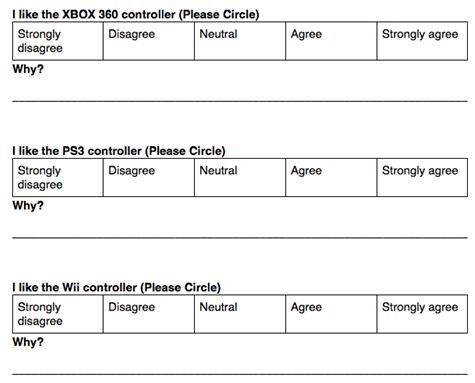
Figure 7. Controller Preference Questionnaire
When all 48 control inputs had been accessed the participant was given a final questionnaire soliciting a preference rating on each controller (see Figure 7). The questionnaire used Likert scale responses to allow for statistical analysis of data; but open-ended space was provided below each item to determine whether the participant consciously liked or disliked a controller because of its size.
3. Results
The relationships between participant hand size and the number of buttons reached by moving out of the "natural" position and between participant hand size and her or his preference were both examined. Results on the number of hand movements are presented first. This is followed by the results on controller preference. Lastly, the relationship between previous controller use and controller preference is considered.
3.1. Hand Size
The 13 participants had a mean hand size of 15.9 inches (SD = 1.2) with a maximum hand size of 18.3 inches and a minimum hand size of 13.0 inches.3.2. Hand Movements
The result of the total number of hand movements for all controllers is shown in Figure 8. The mean number of hand movements performed by each participant was 9.2 (SD = 3.1). The correlation between hand size and number of hand movements was r = -.590, which was statistically significant (t 11 = 2.43, p < .05). The conclusion is that participants with larger hands can often reach more buttons on the controller without having to move their hands from the "natural" position.
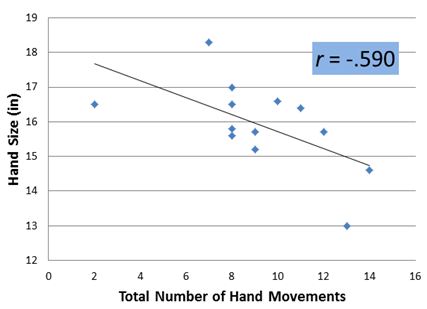
Figure 8. Total number of hand movements by hand size.
Next, the relationship between individual controllers and hand size was looked at. Of the three, only Xbox 360 controller yielded a statistically significant correlation between the number of hand movements and hand size (r = -.697, t 11 = 3.22, p < .01). This strong correlation in the Xbox 360 controller, seen in Figure 9, is possibly because it has the largest dimensions of the three (6.05 in width, 4.13 in height, 2.41 in depth) and so more buttons are inaccessible to those with smaller hands.
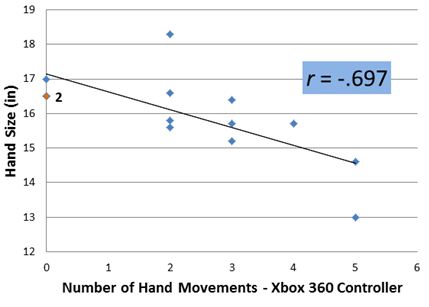
Figure 9. Number of hand movements for Xbox 360 controller by hand size (overlaps indicated by number).
The Wii Remote, while smaller than the Xbox 360 controller and the Playstation 3 controller, is only operated by one hand and so has the highest mean of hand movements at 4.8 (the Xbox 360 and Playstation 3 had 2.4 and 2.0 respectively). The distance between buttons on this controller is so great that even those with large hands must move out of the "natural" position to reach all control inputs. The Nunchuck is much smaller and all three control inputs could be reached without having to leave the "natural" position. Ultimately, it is theorized that the Wii Remote component of this controller is too large to provide significant benefit to users of any particular hand size – making this the most difficult controller to operate.
The last controller is the Playstation 3 controller. This controller was notable for how consistent it was between participants of various hand sizes. While the other two controllers had some level of correlation (significant or not) between hand sizes and number of hand movements, this controller had none (r = .065). Of the 13 participants, 10 had to move their hands out of the natural position for only two buttons ("start" and "select"). It is theorized that the buttons on this controller were so easily accessible that, again, there was no significant benefit to users of any particular hand size.
3.3. User Preference
Based on the results for hand movements, it might be expected that users' preferences also have a correlation with hand size. This is far from the case.
If we compare the results of user preference by hand size for the Xbox 360 controller (Figure 10) with the results of the number of hand movements for this controller (Figure 9), we see near random results (r = .238), compared to the strong correlation seen with hand movements. In the preference graph, scores range from 1 (strongly dislike) to 5 (strongly like). While participants with smaller hands may have a harder time operating the control inputs, this did not seem to affect how much they liked the controller. This result was rather surprising as it is expected that an item that is hard to operate would be less enjoyable, as occurred in the basketball size study (see related work section).

Figure 10. User preference of Xbox 360 controller by hand size (overlaps indicated by number).
The user preference results for the other two controllers also show a weak correlation for the Playstation 3 controller (r = .070) the Wii controller combination (r = .325). These results were essentially random when compared to participant hand size. Participants did seem to prefer the Playstation 3 controller to the Wii controller (mean for the Playstation 3 was 3.5 and for the Wii 2.8) but the difference in preference was not statistically significant (F 2,24 = 1.67, p > .05).
Of the comments in the questionnaire, a few participants indicated they liked a controller because of usability or that they liked a controller because they "used it most often" or found it similar to another controller they were familiar with. This indicates that users might carry a bias from previous experience toward what controller they like. Perhaps these results would be different if participants were to actually use these controllers during gameplay. This would enable them to become familiar with each controller and be more actively aware of benefits and shortcomings.
3.4. Previous Controller Use
The potential bias noted above was statistically significant for the Xbox 360 controller (t 11 = 2.22, p < .05) but not for the other two controllers. The Xbox 360 controller correlation (Figure 11) is a strong relationship with only one outlying point. Previous controller use in this graph ranges from 1 (no prior use) to 4 (use at least once a week).
It is unclear why the trend between controller preference and previous experience only appears for the Xbox 360. It would be expected that this trend would appear for all controllers. A possible explanation is that participants use some controllers frequently yet don't like them. This might be because they enjoy the games available for that gaming system or that they just happen to own the gaming system. It is also possible that infrequent use follows from the price of the system. For example, a new Wii system is about half the price of a new Playstation 3 system and this could affect the exposure of participants, particularly casual gamers.
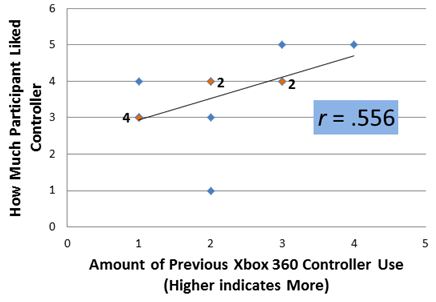
Figure 11. Previous Xbox 360 controller use by user preference of controller (overlaps indicated by number).
4. Conclusion
We studied the effect of a player's hand size on preference and ability to use three controllers: the Wii Remote and Nunchuck controller combination, the Xbox 360 Wireless Gamepad controller, and the Playstation 3 Wireless Duelshock 3 controller. The effect of number of control inputs requiring hand movement was statistically significant. Participants with larger hands could reach more buttons without moving out of the "natural" position, compared to those with smaller hands. When looking at each controller individually, only the Xbox 360 revealed a statistically significant relationship between hand size and the number of control inputs requiring movement of the hand from the "natural" position. This relationship was stronger than that of the relationship over all controllers. For the relationship between user preference and hand size, no statistical significance was found with any of the three controllers. Finally, the relationship between previous controller use and controller preference was only statistically significant for the Xbox 360 controller.
This research demonstrates that a user's hand size has an effect on her or his experience with different game controllers. While significant results were found for the effect of hand size on usability, no significant results were found for the effect of hand size on preference. Further research is needed to determine if this result was due to the lack of experience some participants had with operating the controllers in real game settings.
References
Berguer, R., Hreljac A. (2004). The relationship between hand size and difficulty using surgical instruments: A survey of 726 laparoscopic surgeons. Surgical Endoscopy, 18, 3, 508-512.
Federoff, M. A. (2002). Heuristics and usability guidelines for the creation and evaluation of fun in video games. Doctoral dissertation, Indiana University.
Pellecchia, G. L. (2003). Figure-of-eight method of measuring hand size: Reliability and concurrent validity. Journal of Hand Therapy 16, 4, 300-304.
Pinelle, D., Wong, N., Stach, T. (2008). Heuristic evaluation for games: Usability principles for video game design. In Proc. CHI 2008, ACM Press,1458-1462.
Regimbal, C., Deller, J., Plimpton, C. (1992). Basketball size as related to children's preference, rated skill, and scoring. Perceptual and Motor Skills 75, 3, 867-872.
Sperling, L., Dahlman, S., Wikstrom, L., Kilbom, A., Kadefors, R. (1993). A cube model for the classification of work with hand tools and the formation of functional requirements. Applied Ergomics 24, 3, 212-220.
Tracy, R. and Picon, M. (2010). How super is Mario? Newsweek, November 15, 68-70.
Source: https://www.yorku.ca/mack/mhci2013c.html
0 Response to "Compare and Contrast a Woman and Game Controller Funny"
Post a Comment